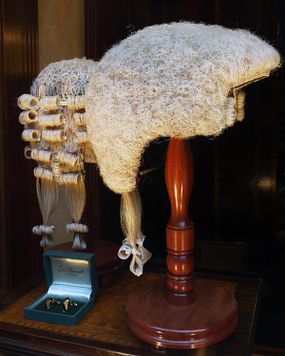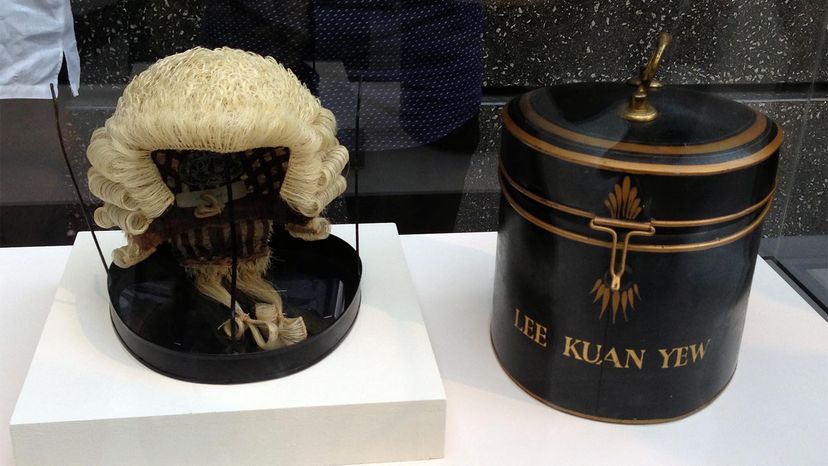
The drama of a criminal trial has a macabre allure. In America, strangers line up to enter courtrooms as spectators of high-profile proceedings. Those who can't be there in person watch live-streamed versions on televisions and tablets. And when there's downtime from real-life court battles, many turn instead to pseudo-fictional prime-time portrayals.
But in the U.K., nothing is more British than the iconic white wig judges and attorneys — or barristers as they're known — wear during formal courtroom proceedings. Many of the judges and barristers who wear wigs say the headpiece — also known as a peruke — brings a sense of formality and solemnity to the courtroom.
Advertisem*nt
"In fact, that is the overwhelming point for having them," Kevin Newton, a Washington, D.C.-based lawyer who studied law at the University of London, said when we originally spoke to him in 2017. Newton added that barristers' counterparts, known as solicitors, meet with clients outside the courtroom and don't wear wigs.
Contents
- A Desire for Uniformity
- Historical Hair
- A Persistent Legacy
A Desire for Uniformity
Like the robes the lawyers wear, the wigs are worn as a symbol of anonymity, Newton said. The wigs are part of a uniform that create a visual separation between the law and those being brought up before it. Wigs are so much a part of British criminal courts that if a barrister doesn't wear one, it's seen as an insult to the court.
Barrister wigs are curled at the crown, with horizontal curls on the sides and back. Judges' wigs — also called bench wigs — look similar, but are typically more ornate. They're fuller at the top and transition into tight curls that fall just below the shoulders.

Most are handmade from 100 percent horsehair, though there are synthetic versions available today, too. Horsehair wigs aren't cheap, either, especially when they're handmade and combine an ages-old craft of styling, sewing and gluing. A judge's full-length wig can cost more than $3,000, while the shorter ones worn by barristers cost more than $600.
Wigs may have fallen out of fashion over the centuries, but when they first made their appearance in a courtroom around 1685, they were part and parcel of being a well-dressed professional.
In the 17th century, only the elite wore powdered wigs made of horsehair. Those who couldn't afford the best garb but wanted to look the part wore wigs made of hair from goats, spooled cotton or from the hair of human corpses. There was also a steady trade that involved living people who sold their long hair for wigs, though horsehair remained the ideal.
But why did powdered wigs come on the fashion scene in the first place? Why top one's head with an itchy, sweat-inducing mass of artificial curls? Blame it on syphilis.
Advertisem*nt
Historical Hair
Wigs began to catch on in the late 16th century when an increasing number of people in Europe were contracting the STI. Without widespread treatment with antibiotics (Sir Alexander Fleming didn't discover penicillin, the treatment for syphilis until 1928), people with syphilis were plagued by rashes, blindness, dementia, open sores and hair loss. The hair loss was particularly problematic in social circles. Long hair was all the rage, and premature balding was a dead giveaway that someone had contracted syphilis.
Wigs, when not used to cover syphilis-related hair loss, were also a helpful for those who had lice. After all, it was much more difficult to treat and pick through the hair on one's head than it was to sanitize a wig.
Advertisem*nt
When it comes to trend-starters, no one had a bigger influence on British wigs than Louis XIV of France. During his reign from 1643 to 1715, the Sun King disguised his prematurely balding scalp — historians believe it was caused by syphilis — by wearing a wig. In doing so, he started a trend that was widely followed by the European upper- and middle-class, including his cousin, Charles II, the King of England (also rumored to have contracted syphilis), who reigned from 1660 to 1685.
Although aristocrats and those who wished to remain in good social standing were quick to adopt the practice of wearing wigs, English courtrooms were slower to act. In the early 1680s, judicial portraits still showed a natural, no-wig look. By 1685, however, full, shoulder-length wigs had become part of the proper court dress.

Advertisem*nt
A Persistent Legacy
Over time, wigs fell out of fashion with society as a whole. During the reign of England's King George III, from 1760 to 1820, wigs were worn by only a few — namely bishops, coachmen and those in the legal profession. And bishops were permitted to stop wearing them in the 1830s. But the courts kept wigs for hundreds of years more.
In 2007, though, new dress rules did away with barrister wigs — for the most part. Wigs were no longer required during family or civil court appearances, or when appearing before the Supreme Court of the United Kingdom. Wigs, however, remain in use in criminal cases.
Advertisem*nt
And in Ireland, judges continued to wear wigs until 2011, until the practice was discontinued. In England, and other former English and British colonies — like Canada, for instance, whose provinces abandoned the wigs throughout the 19th and 20th centuries, or Jamaica, which removed the wigs in 2013 — lawyers and judges now only wear wigs for ceremonies.
Yet, wearing wigs still enjoys popularity among British lawyers, the Guardian reported in 2021. "If you don't meet the physical stereotypes of a barrister — male, white, perhaps older — it is helpful to wear the uniform because it stops any awkward conversations," barrister Zoe Chapman told the publication.
Now That's Interesting
Before the adoption of wigs in the 17th century, British lawyers had a dress code that would seem positively modern. They were expected to appear in court with short hair and neatly trimmed beards.
Advertisem*nt
Originally Published: Apr 17, 2017
Lawyer Wigs FAQ
Why do British lawyers wear wigs?
British lawyers follow the tradition of wearing head wigs, which is regarded as a symbol of power and respect for the law. In fact, not wearing a wig is perceived as an insult to the courts. British lawyers and judges wear wigs to portray their formality in the courtroom and to pay homage to legal history.
What is another name for barristers wig?
A barrister’s wig is also called a peruke. It’s long, curly, blonde or white, and goes to about the nape of the neck.
How much does a barristers wig cost?
Perukes or barristers wigs vary in price. For example, a full-head long-hair wig worn by judges can cost up to $3,000. However, the ones worn by barristers tend to be less expensive, costing around $500.
Why did British lawyers start wearing wigs?
In the 17th and 18th century, wigs rose in popularity to cover up baldness, but soon after, it became a trend among the English upper-class when the King of England, Charles II, also started using a wig. Lawyers adopted the dress code to communicate their sophistication.
What are British court wigs made of?
British court wigs are handcrafted and made with quality horsehair that can be quite costly. During the 17th century, only the elite class wore powdered hair wigs made with horsehair. The middle-class wore wigs made of human or goat hair.